Sunday, November 13, 2005
bubble, bubble, toil, and trouble...
I’ve pretty much got the process down now, but it took a lot of time and trial and error. Rick and I have estimated that I probably made 20 or so batches of soap before getting one to work. And that’s a lot of money (and soap) down the drain, peeps! The challenge is that there are so many things that can go wrong at each step. So each time something does go wrong, you have to isolate it, go back, and try again, modifying that one thing. Then, that part might go right, but another step goes wrong. You get the idea. Frustrating, yes. But also fascinating. It’s the scientific process at work!
Here are some pictures of yesterday’s soap-making. There aren’t too many, because timing is crucial in making soap, so I couldn’t stop to snap photos as often as I wanted.
First, here’s a shot of all my soap-making supplies. I’ve accumulated lots of scents, colors, and other ingredients over the years, and since I make a lot of soap, I started ordering the fixed oils (olive, coconut, and palm) in 5 gallon buckets. I keep everything on a big rolling cart that fits into our spare room closet when I’m not making soap. 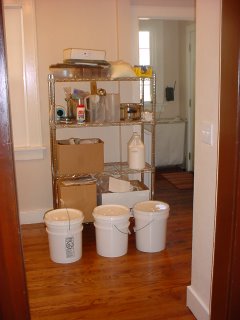
The first thing I do, after setting everything out with my typical anal precision, is measure out all my oils and heat them up to melt them. 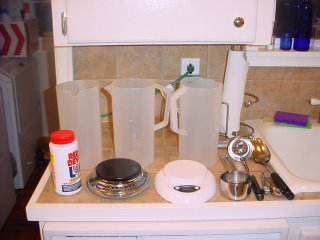
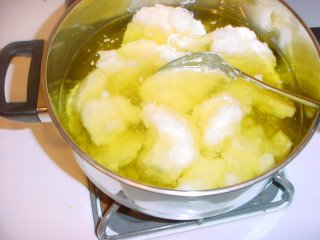 Then I mix my lye with cold water. You have to be very careful during this step. In fact, any book or site about soap-making will tell you to wear gloves and goggles when making soap. Mixing lye and water causes a chemical reaction that will burn your skin (see Fight Club for an example)…but don’t worry, after the soap has cured for a month, it is mild as can be. I used to wear the goggles, gloves, and an apron, but I’ve been doing this so long now that I am just really careful. So far, so good. But kids, do as I say, not as I do. In fact, you shouldn’t be making soap at all and I’m telling your mother!
Then I mix my lye with cold water. You have to be very careful during this step. In fact, any book or site about soap-making will tell you to wear gloves and goggles when making soap. Mixing lye and water causes a chemical reaction that will burn your skin (see Fight Club for an example)…but don’t worry, after the soap has cured for a month, it is mild as can be. I used to wear the goggles, gloves, and an apron, but I’ve been doing this so long now that I am just really careful. So far, so good. But kids, do as I say, not as I do. In fact, you shouldn’t be making soap at all and I’m telling your mother!
The lye and cold water instantly heat up to about 160 degrees and create a powerful bunch of fumes that makes you cough and your eyes water if you stand over it…learned that from experience, I did. I tried to get a pic of the fumes, but I don’t think it worked. 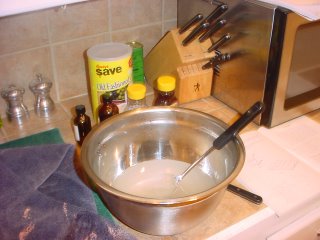
And then…we wait. The lye mixture and the oil mixture have to cool down to about 110-125 degrees each. This takes a while. So in the meantime, I get everything else ready. I’m making honey oatmeal soap, so I measure all the goodies that will be added at the end. 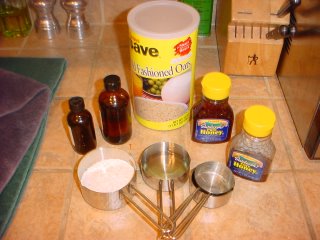
When the mixtures are cool enough, I pour the lye water into the oil and use a stick blender to mix the two together. If you mix this with just a spoon and muscle energy, it can take up to two hours to saponify, which is when the two mixtures finally come together enough that it is liquid soap. With the stick blender, it takes about five minutes. Sometimes less, if it’s hot in the room. I love my stick blender! 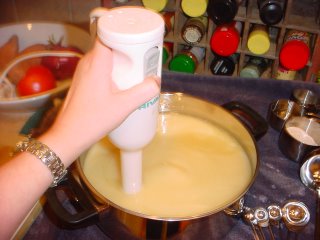
I pour the saponified soap in to molds, and cover with towels to keep them warm. In twenty four hours, I remove the towels and pop out the individual bars, which will have hardened but are still a little bit soft. And after sitting 28 days, it’s ready to use.
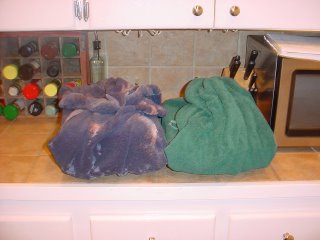
 These honey oatmeal soaps look a little like blond brownies or something, so don't get confused and try to eat one! Trust me, they don't taste as good as they look.
These honey oatmeal soaps look a little like blond brownies or something, so don't get confused and try to eat one! Trust me, they don't taste as good as they look.
I can tell that is one hobby I might not be trying anytime soon. That is a lot of STUFF to have for it.
I want a blender like that.
And I can't wait for GoF!
Gee, that wasn't random at all was it?
Saponify. S A P O N I F Y. Sounds a bit like a superhero supah power. Quick, soap girl! Saponify!
Nanda
And Rosemary, you are right! There is a LOT of STUFF involved. I think that's part of the reason why I didn't give up as quickly as I have given up on other new hobbies. There was a lot of family cash invested!
Nanda
(this post written with the help of Kah-raZEE Justin)
Now I'm thinking of "Saponify!" as a spell (a la JK Rowling) that will cause the recipient to speak a Siouan language and be unintelligible to the rest of the Brits at Hogwarts.
See the direction my mind goes?
<< Home



